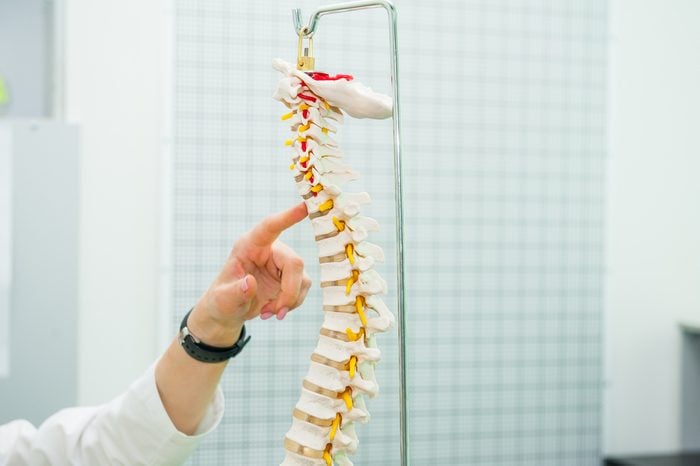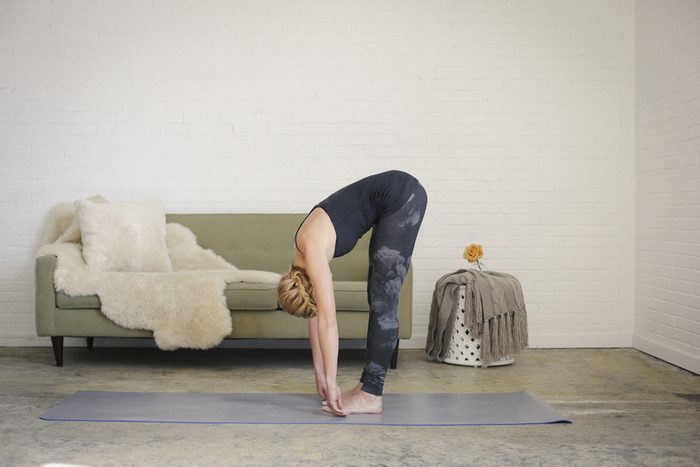You can have bad posture at any age
Posture is an issue for older people, right? Not at all, say experts. “It’s a concern for everyone,” says Eeric Truumees, MD, director of spine research at Dell Seton Medical Center at The University of Texas, Austin. In fact, health conditions that affect the spine also impact your brain and nervous system, and can have a huge effect on your well-being. “While some conditions are more easily understood and treatable, spine and posture issues sneak up on you and can be hard to manage once they appear,” Dr. Truumees says. Here’s what you need to know about keeping your posture, and your overall health, in great shape.

What is posture, anyway?
There are two types of posture, according to the National Institutes of Health: dynamic posture (your body position when moving) and static posture (your body position when sitting, standing, or sleeping). Good posture means that your head sits above your shoulders and your shoulders are over your hips, a position that maintains a neutral spine. (Here are some tips to go from bad posture to good posture.)

Thanks, electronic devices
Our phones and tablets aren’t going away, but “the problem is that as we become more and more dependent on these devices, we are getting used to sitting or standing in a hunched-over position that contributes to poor posture,” says sports-medicine doctor Stacy Spivack, MD, at CareMount Medical in Mount Kisco, New York. While electronics use tends to affect your neck and shoulders, your spine also can be harmed.

Bad posture can trigger muscle spasms
It’s hardly surprising—but worth a reminder—that if you sit while slouched over, which drives your head and neck forward, you may be left with significant neck pain and spasms, says Dr. Spivack. Correcting bad posture may offer a significant source of relief for the nearly 20 percent of the population with neck pain, according to a 2018 study in the Brazilian Journal of Physical Therapy. (Try these home remedies for neck pain.)

Bad posture can make it hurt to move
The body likes to be in alignment. But when you’re sitting and standing with poor posture day in and day out, your body gets used to it. It accepts it as the new normal—something that can spell trouble for you. “When your muscles become accustomed to being in a shortened position, it may hurt to move,” says Dr. Spivack. Getting ahead of these bad posture habits now can help prevent nerve damage, osteoarthritis, and musculoskeletal problems later in life, says Dr. Truumees. (Ready to make a change? Find out if posture correctors work.)

Bad posture can make you weaker
Even if you’re not feeling it, stand tall. In one 2016 study on 33 people published in the journal Biofeedback, people took turns standing erect or slouched. When they stood with better posture, they had greater arm strength during a strength test than when they stood in a saggy position. Studies published in 2016 in the the Journals of Gerontology, Biological Sciences and Medical Sciences, suggest body-weight workouts such as yoga that improve flexibility as well as body strength are best to keep the spine strong, supple, and pain-free. (Find out what else can cause one-sided lower back pain.)

Bad posture can contribute to rib pain
If your shoulders remain rounded for much of the day, your body will compensate. “The chest wall will become tight, causing rib and sternal [sternum] pain,” says Dr. Spivack. Rib pain can also be a sign that something else is going on—including shingles or costochondritis (inflammation of the cartilage between the ribs), notes Szu-Ping Lee, PT, PhD, associate professor, department of physical therapy, school of integrated health sciences at the University of Nevada, Las Vegas. (Shingles is a reactivation of the chicken pox virus that can cause pain and blisters on one side of the body that has nothing to do with posture.) Here are some exercises for rounded shoulders that can improve your posture.

Bad posture brings you down
A droopy body leads to a droopy mindset. While research shows upright posture improves self-esteem and mood in just about everyone, a 2017 study published in the Journal of Behavior Therapy and Experimental Psychiatry, suggests adopting an upright posture may also help depressed people feel happier and less fatigued, and self-conscious. The lesson? Instead of letting the day get you down, sit up and see how you feel.

Bad posture can exacerbate arthritis
If you’re suffering from arthritic changes in your shoulders, hips, or spine, poor posture can worsen the pain, says Dr. Spivack. Plus, if you’re dealing with arthritis in your neck, the head-forward position can pinch a nerve, resulting in tingling that radiates down your arm, she says. (Find out these other sneaky reasons your neck hurts.)

Bad posture can make you tired
People who have mild to moderate depression are more likely to hunch over than others. While there are many factors that can contribute to a mood disorder, focusing on better posture may at least help. A 2019 study published in the Journal of Behavior Therapy and Experimental Psychiatry found that standing and walking upright can lead to improved psychological states, including better mood, less pain, and even more “feelings of power” than those who walked slumped over. And people who are tired may have bad posture.

Bad posture is hard on your lungs
Feeling as if you’re not breathing easy these days? It might be due in part to your phone usage. For a 2016 study published in Journal of Physical Therapy Science, researchers compared people who used their smartphones for less than four hours a day with those who used their phones longer. They found that people who spent more time on their phone had worse posture, which may compress the lungs and compromise respiratory function.

Bad posture may trigger heartburn
If you’ve ever been saddled with stomach symptoms, check your slouch. Sitting slumped over, especially after eating, can give you a belly ache and even trigger acid reflux and heartburn. “If you slouch too much, you put pressure on your abdomen and can eventually affect your digestion,” adds Dr. Truumees. “It’s better to take a quick walk.”

How you can improve your posture
Yes, you’ll need to straighten out, but first, one powerful habit that combats bad posture is getting up more. “Avoid sitting in one position for a prolonged period of time,” says Dr. Spivack. She suggests standing every 30 minutes for at a minimum of a few minutes at a time. If you need a reminder so that you don’t get lost in work to-dos, set a timer. (Find out the signs that back pain is really arthritis.)

Switch up your space
If your works allows it, talk to human resources about the possibility of getting a sit-to-stand desk. “This is a newer change we’re encouraging patients to take advantage of,” says Dr. Spivack. “This allows you to stand for parts of the day and alternate as needed with sitting.”

Make changes
An ergonomic desk setup that addresses the height of your computer screen, keyboard, and chair is necessary for improving your posture while you sit, says Dr. Spivack. Every time you sit down to work, take time to make sure your setup is correct. If you need specific tips, follow these rules of desk ergonomics that will lessen pain and hone your focus and energy.

There’s an app for that
There are a slew of apps and trackers that help with all your health goals, including those that send an alert when you’re slumping. Dr. Truumees says people who enjoy technology seem to respond well to these features, but notes that no one should spend a lot of money on a high-tech solution to what is usually a low-tech problem. “It may just as effective to have someone in your life remind you to stand up straight,” he notes.

